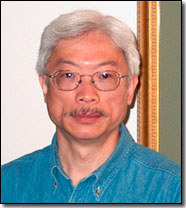
2005 IEEE International Conference on Acoustics, Speech, and Signal Processing
March 18-23, 2005 • Pennsylvania Convention Center/Marriott Hotel • Philadelphia, PA, USA
ICASSP
30th Anniversary
Making Machines Speak and Listen - Why It is Still Interesting
Date: Wednesday, March 23, 08:00 - 09:00
Location: Exhibit Hall C
Presented by
Prof. Biing Hwang (Fred) Juang, Georgia Institute of Technology
Abstract
Designing a machine that mimics human behavior, particularly the capability of speaking naturally and responding properly to spoken language, has intrigued engineers and scientists for centuries. The first workable engineering concept was the framework for the analysis and synthesis of speech proposed by Homer Dudley at Bell Telephone Laboratories in the 1930's. Since then, technological development in speech recognition and synthesis has made a remarkable progress, from a simple machine that responds to a small set of sounds of a phonemic nature to a sophisticated system that converses with human in fluently spoken natural language, in a limited and controlled sense. The progress, to a large extent, can be attributed to the data-driven approach supported by the underlying signal processing ideas and mathematical formalisms. Today, automatic speech systems find widespread application in tasks that require a human-machine interface, such as automatic call processing in the telephone network and query-based information systems that offer updated travel information, stock price quotations, weather reports, etc.
In light of these "successes," one might ask a rather penetrating question: Is speech processing, recognition as well as synthesis, a solved problem? In this talk, we’ll review some major highlights in the research and development of automatic speech systems in the past and attempt to answer the above question by pointing out the limitations of today’s speech technology and the remaining challenges. We’ll also discuss several new, exciting efforts that are interesting and inspiring, something that hold the potential of opening the next chapter of speech technology in this relentless scientific pursuit.
Speaker Biography
 Professor Biing Hwang (Fred) Juang received his Ph.D. from
University of California, Santa Barbara. He had worked at Speech Communications
Research Laboratory (SCRL) and Signal Technology, Inc. (STI) on a number of
Government-sponsored research projects. Notable accomplishments during the
period include development of vector quantization for voice applications, voice
coders at extremely low bit rates, 800 bps and around 300 bps, and robust
vocoders for use in satellite communications. He was also a co-Principal
Investigator for the project on co-channel separation of speech signals
sponsored by the Department of Defense. Prof. Juang subsequently joined the
Acoustics Research Department of Bell Laboratories in 1982, working in the area
of speech enhancement, coding and recognition. Prof. Juang became Head/Director
of Acoustics and Speech Research at Bell Labs, and Director of Multimedia
Technologies Research at Avaya Labs (a spin-off of Bell Labs) in 2001. His
group continued the long heritage of Bell Labs in speech communication
research.
Professor Biing Hwang (Fred) Juang received his Ph.D. from
University of California, Santa Barbara. He had worked at Speech Communications
Research Laboratory (SCRL) and Signal Technology, Inc. (STI) on a number of
Government-sponsored research projects. Notable accomplishments during the
period include development of vector quantization for voice applications, voice
coders at extremely low bit rates, 800 bps and around 300 bps, and robust
vocoders for use in satellite communications. He was also a co-Principal
Investigator for the project on co-channel separation of speech signals
sponsored by the Department of Defense. Prof. Juang subsequently joined the
Acoustics Research Department of Bell Laboratories in 1982, working in the area
of speech enhancement, coding and recognition. Prof. Juang became Head/Director
of Acoustics and Speech Research at Bell Labs, and Director of Multimedia
Technologies Research at Avaya Labs (a spin-off of Bell Labs) in 2001. His
group continued the long heritage of Bell Labs in speech communication
research.
Prof. Juang has published extensively, including the book "Fundamentals of Speech Recognition," co-authored with L.R. Rabiner, "Pattern Recognition in Speech and Language Processing," with Wu Chou, and holds about twenty patents. He has served as Editor-in-Chief for the IEEE Transactions on Speech and Audio Processing, and a number of positions in the IEEE Signal Processing Society, including current Chair of its Fellow Evaluation Committee. Prof. Juang has received a number of technical awards, notable among which are several Best Paper awards in the area of speech communications and processing, the Technical Achievement Award from the IEEE Signal Processing Society, and the IEEE Third Millennium Medal. He is a Fellow of the IEEE, a Fellow of Bell Laboratories, and a member of the National Academy of Engineering of the United States. He is currently Motorola Foundation Chair Professor at the School of Electrical & Computer Engineering, Georgia Institute of Technology which he joined in 2002. Prof. Juang is also an Eminent Scholar of the Georgia Research Alliance.